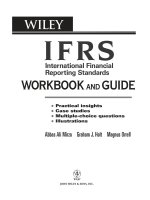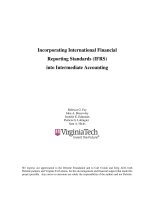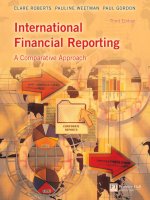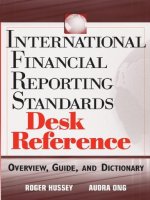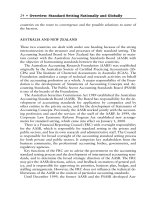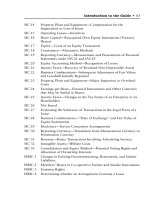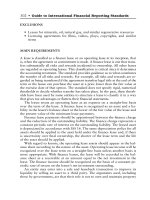IFRS IFRS international financial reporting standards part b (2010)
Bạn đang xem bản rút gọn của tài liệu. Xem và tải ngay bản đầy đủ của tài liệu tại đây (9.76 MB, 1,900 trang )
International Financial Reporting
Standards®
as issued at 1 January 2010
This edition published in two parts
PART B
International Financial Reporting
Standards®
as issued at 1 January 2010
This edition published in two parts
PART B
The consolidated text of documents accompanying International Financial
Reporting Standards (IFRSs®) including International Accounting
Standards (IASs®) and Interpretations, as published at 1 January 2010,
together with the IASB Framework, IASC Foundation procedural documents
and the Glossary of Terms.
For the unaccompanied IFRSs, see Part A of this edition
International Accounting Standards Board®
30 Cannon Street
London EC4M 6XH
United Kingdom
Telephone: +44 (0)20 7246 6410
Fax: +44 (0)20 7246 6411
Email:
Publications Telephone: +44 (0)20 7332 2730
Publications Fax: +44 (0)20 7332 2749
Publications Email:
Web: www.iasb.org
IFRSs together with their accompanying documents are issued by the
International Accounting Standards Board (IASB),
30 Cannon Street, London EC4M 6XH, United Kingdom.
Tel: +44 (0)20 7246 6410 Fax: +44 (0)20 7246 6411
Email: Web: www.iasb.org
ISBN for this part: 978-1-907026-62-1
ISBN for complete publication (two parts): 978-1-907026-60-7
Copyright © 2010 International Accounting Standards Committee Foundation
(IASCF).
International Financial Reporting Standards, International Accounting
Standards, Interpretations, Exposure Drafts, and other IASB publications are
copyright of the IASCF. The approved text of International Financial Reporting
Standards, including International Accounting Standards and Interpretations, is
that issued by the IASB in the English language. Copies may be obtained from the
IASCF Publications Department. Please address publication and copyright
matters to:
IASC Foundation Publications Department
30 Cannon Street, London EC4M 6XH, United Kingdom.
Telephone: +44 (0)20 7332 2730 Fax: +44 (0)20 7332 2749
Email: Web: www.iasb.org
All rights reserved. No part of this publication may be translated, reprinted or
reproduced or utilised in any form either in whole or in part or by any electronic,
mechanical or other means, now known or hereafter invented, including
photocopying and recording, or in any information storage and retrieval system,
without prior permission in writing from the IASCF.
The IASB, the IASCF, the authors and the publishers do not accept responsibility
for loss caused to any person who acts or refrains from acting in reliance on the
material in this publication, whether such loss is caused by negligence or
otherwise.
The IASB logo/the IASCF logo/‘Hexagon Device’, the IASC Foundation Education logo,
‘IASC Foundation’, ‘eIFRS’, ‘IAS’, ‘IASB’, ‘IASC’, ‘IASCF’, ‘IASs’, ‘IFRIC’, ‘IFRS’, ‘IFRSs’,
‘International Accounting Standards’, ‘International Financial Reporting Standards’ and
‘SIC’ are Trade Marks of the IASCF.
Contents
Documents accompanying:
International Financial Reporting Standards (IFRSs)
IFRS 1
First-time Adoption of International Financial Reporting
Standards
IFRS 2
Share-based Payment
IFRS 3
Business Combinations
B187
IFRS 4
Insurance Contracts
B343
IFRS 5
Non-current Assets Held for Sale and Discontinued Operations
B453
IFRS 6
Exploration for and Evaluation of Mineral Resources
B489
IFRS 7
Financial Instruments: Disclosures
B509
IFRS 8
Operating Segments
B555
IFRS 9
Financial Instruments
B603
B1
B73
International Accounting Standards (IASs)
IAS 1
Presentation of Financial Statements
B645
IAS 2
Inventories
B695
IAS 7
Statement of Cash Flows
B701
IAS 8
Accounting Policies, Changes in Accounting Estimates and
Errors
B713
IAS 10
Events after the Reporting Period
B727
IAS 11
Construction Contracts
B731
IAS 12
Income Taxes
B737
IAS 16
Property, Plant and Equipment
B759
IAS 17
Leases
B771
IAS 18
Revenue
B783
IAS 19
Employee Benefits
B793
IAS 20
Accounting for Government Grants and Disclosure of
Government Assistance
B863
IAS 21
The Effects of Changes in Foreign Exchange Rates
B865
IAS 23
Borrowing Costs
B879
IAS 24
Related Party Disclosures
B891
IAS 27
Consolidated and Separate Financial Statements
B913
IAS 28
Investments in Associates
B951
IAS 29
Financial Reporting in Hyperinflationary Economies
B961
IAS 31
Interests in Joint Ventures
B963
IAS 32
Financial Instruments: Presentation
B971
© IASCF
v
IAS 33
Earnings per Share
B1025
IAS 34
Interim Financial Reporting
B1057
IAS 36
Impairment of Assets
B1069
IAS 37
Provisions, Contingent Liabilities and Contingent Assets
B1177
IAS 38
Intangible Assets
B1189
IAS 39
Financial Instruments: Recognition and Measurement
B1227
IAS 40
Investment Property
B1423
IAS 41
Agriculture
B1447
Interpretations
IFRIC 1
Changes in Existing Decommissioning, Restoration and Similar
Liabilities
B1477
IFRIC 2
Members’ Shares in Co-operative Entities and Similar
Instruments
B1491
IFRIC 4
Determining whether an Arrangement contains a Lease
B1499
IFRIC 5
Rights to Interests arising from Decommissioning, Restoration
and Environmental Rehabilitation Funds
B1513
IFRIC 6
Liabilities arising from Participating in a Specific Market—
Waste Electrical and Electronic Equipment
B1521
IFRIC 7
Applying the Restatement Approach under IAS 29 Financial
Reporting in Hyperinflationary Economies
B1525
IFRIC 9
Reassessment of Embedded Derivatives
B1539
IFRIC 10 Interim Financial Reporting and Impairment
B1547
IFRIC 12 Service Concession Arrangements
B1551
IFRIC 13 Customer Loyalty Programmes
B1583
IFRIC 14 IAS 19—The Limit on a Defined Benefit Asset, Minimum
Funding Requirements and their Interaction
B1593
IFRIC 15 Agreements for the Construction of Real Estate
B1611
IFRIC 16 Hedges of a Net Investment in a Foreign Operation
B1625
IFRIC 17 Distributions of Non-cash Assets to Owners
B1637
IFRIC 18 Transfers of Assets from Customers
B1653
IFRIC 19 Extinguishing Financial Liabilities with Equity Instruments
B1661
SIC-7
Introduction of the Euro
B1669
SIC-10
Government Assistance—No Specific Relation to Operating
Activities
B1671
SIC-12
Consolidation—Special Purpose Entities
B1673
SIC-13
Jointly Controlled Entities—Non-Monetary Contributions by
Venturers
B1679
SIC-15
Operating Leases—Incentives
B1683
SIC-21
Income Taxes—Recovery of Revalued Non-Depreciable Assets
B1687
vi
© IASCF
SIC-25
Income Taxes—Changes in the Tax Status of an Entity or its
Shareholders
B1689
SIC-27
Evaluating the Substance of Transactions Involving the Legal
Form of a Lease
B1691
SIC-29
Service Concession Arrangements: Disclosures
B1697
SIC-31
Revenue—Barter Transactions Involving Advertising Services
B1699
SIC-32
Intangible Assets—Web Site Costs
B1701
*****
Approval by the Board of Improvements to IFRSs
issued in May 2008
B1707
Approval by the Board of Improvements to IFRSs
issued in April 2009
B1708
*****
Framework for the Preparation and Presentation of Financial
Statements
B1709
IASC Foundation Constitution
B1735
Due Process Handbook for the IASB
B1749
Due Process Handbook for the IFRIC
B1775
Glossary of Terms
B1787
Index
B1839
© IASCF
vii
IFRS 1
IASB documents published to accompany
International Financial Reporting Standard 1
First-time Adoption of International
Financial Reporting Standards
This version includes amendments resulting from IFRSs issued up to 31 December 2009.
The text of the unaccompanied IFRS 1 is contained in Part A of this edition. Its effective
date is 1 July 2009. The effective date of the latest amendments is 1 January 2013. This part
presents the following accompanying documents:
page
APPROVAL BY THE BOARD OF IFRS 1 ISSUED IN NOVEMBER 2008
B2
APPROVAL BY THE BOARD OF ADDITIONAL EXEMPTIONS FOR FIRST-TIME
ADOPTERS (AMENDMENTS TO IFRS 1) ISSUED IN JULY 2009
B3
BASIS FOR CONCLUSIONS
B4
IMPLEMENTATION GUIDANCE
B38
TABLE OF CONCORDANCE
B71
© IASCF
B1
IFRS 1
Approval by the Board of IFRS 1 issued in November 2008
International Financial Reporting Standard 1 First-time Adoption of International Financial
Reporting Standards (as revised in 2008) was approved for issue by the thirteen members of
the International Accounting Standards Board.*
Sir David Tweedie
Chairman
Thomas E Jones
Vice-Chairman
Mary E Barth
Stephen Cooper
Philippe Danjou
Jan Engström
Robert P Garnett
Gilbert Gélard
James J Leisenring
Warren J McGregor
John T Smith
Tatsumi Yamada
Wei-Guo Zhang
*
B2
Professor Barth and Mr Danjou dissented from Cost of an Investment in a Subsidiary, Jointly Controlled
Entity or Associate (Amendments to IFRS 1 and IAS 27) issued in May 2008. Their dissenting opinions
are set out after the Basis for Conclusions on IAS 27.
© IASCF
IFRS 1
Approval by the Board of Additional Exemptions for First-time
Adopters (Amendments to IFRS 1) issued in July 2009
Additional Exemptions for First-time Adopters (Amendments to IFRS 1) was approved for issue by
the fourteen members of the International Accounting Standards Board.
Sir David Tweedie
Chairman
Thomas E Jones
Vice-Chairman
Mary E Barth
Stephen Cooper
Philippe Danjou
Jan Engström
Robert P Garnett
Gilbert Gélard
Prabhakar Kalavacherla
James J Leisenring
Warren J McGregor
John T Smith
Tatsumi Yamada
Wei-Guo Zhang
© IASCF
B3
IFRS 1 BC
CONTENTS
paragraphs
BASIS FOR CONCLUSIONS ON
IFRS 1 FIRST-TIME ADOPTION OF
INTERNATIONAL FINANCIAL REPORTING STANDARDS
INTRODUCTION
BC1–BC3
RESTRUCTURING OF THE IFRS
BC3A–BC3B
SCOPE
BC4–BC6
BASIC CONCEPTS
BC7–BC15
Useful information for users
BC7–BC8
Comparability
BC9–BC10
Current version of IFRSs
BC11–BC15
OPENING IFRS BALANCE SHEET
BC16–BC84
Recognition
BC17–BC19
Derecognition in accordance with previous GAAP
BC20–BC23
Measurement
BC24–BC29
Benefits and costs
BC26–BC29
Exemptions from other IFRSs
BC30–BC63E
Business combinations
BC31–BC40
Deemed cost
BC41–BC47E
Employee benefits
BC48–BC52
Cumulative translation differences
BC53–BC55
Compound financial instruments
BC56–BC58
Investments in subsidiaries, jointly controlled entities and associates
Assets and liabilities of subsidiaries, associates and joint ventures
BC59–BC63
Designation of previously recognised financial instruments
BC63A
Share-based payment transactions
BC63B
Changes in existing decommissioning, restoration and similar
liabilities included in the cost of property, plant and equipment
BC63C–BC63CA
Leases
BC63D–BC63DB
Borrowing costs
BC63E
Other possible exemptions rejected
BC64–BC73
Embedded derivatives
BC65–BC66
Hyperinflation
B4
BC58A–BC58M
BC67
Intangible assets
BC68–BC71
Transaction costs: financial instruments
BC72–BC73
© IASCF
IFRS 1 BC
Retrospective designation
BC74–BC83A
Hedge accounting
BC75–BC80
Available-for-sale financial assets
BC81–BC83A
Estimates
BC84
PRESENTATION AND DISCLOSURE
BC85–BC96
Comparative information
BC85–BC89A
Historical summaries
BC90
Explanation of transition to IFRSs
BC91–BC95
Interim financial reports
BC96
APPENDIX
Amendment to Basis for Conclusions on other IFRSs
© IASCF
B5
IFRS 1 BC
Basis for Conclusions on
IFRS 1 First-time Adoption of International Financial
Reporting Standards
This Basis for Conclusions accompanies, but is not part of, IFRS 1.
In this Basis for Conclusions the terminology has not been amended to reflect the changes made by IAS 1
Presentation of Financial Statements (as revised in 2007).
This Basis for Conclusions has not been revised to reflect the restructuring of IFRS 1 in November 2008,
but cross-references have been updated.
Introduction
BC1
This Basis for Conclusions summarises the International Accounting Standards
Board’s considerations in reaching the conclusions in IFRS 1 First-time Adoption of
International Financial Reporting Standards. Individual Board members gave greater
weight to some factors than to others.
BC2
SIC-8 First-time Application of IASs as the Primary Basis of Accounting, issued in 1998,
dealt with matters that arose when an entity first adopted IASs. In 2001, the Board
began a project to review SIC-8. In July 2002, the Board published ED 1 First-time
Application of International Financial Reporting Standards, with a comment deadline of
31 October 2002. The Board received 83 comment letters on ED 1. IFRS 1 was
issued by the Board in June 2003.
BC2A
IFRS 1 replaced SIC-8. The Board developed the IFRS to address concerns that:
BC2B
B6
(a)
some aspects of SIC-8’s requirement for full retrospective application
caused costs that exceeded the likely benefits for users of financial
statements. Moreover, although SIC-8 did not require retrospective
application when this would be impracticable, it did not explain whether a
first-time adopter should interpret impracticability as a high hurdle or a
low hurdle and it did not specify any particular treatment in cases of
impracticability.
(b)
SIC-8 could require a first-time adopter to apply two different versions of a
standard if a new version were introduced during the periods covered by its
first financial statements prepared under IASs and the new version
prohibited retrospective application.
(c)
SIC-8 did not state clearly whether a first-time adopter should use hindsight
in applying recognition and measurement decisions retrospectively.
(d)
there was some doubt about how SIC-8 interacted with specific transitional
provisions in individual standards.
Like SIC-8, IFRS 1 requires retrospective application in most areas. Unlike SIC-8, it:
(a)
includes targeted exemptions to avoid costs that would be likely to exceed
the benefits to users of financial statements, and a small number of other
exceptions for practical reasons.
(b)
clarifies that an entity applies the latest version of IFRSs.
© IASCF
IFRS 1 BC
BC3
(c)
clarifies how a first-time adopter’s estimates in accordance with IFRSs
relate to the estimates it made for the same date in accordance with
previous GAAP.
(d)
specifies that the transitional provisions in other IFRSs do not apply to a
first-time adopter.
(e)
requires enhanced disclosure about the transition to IFRSs.
The project took on added significance because of the requirement for listed
European Union companies to adopt IFRSs in their consolidated financial
statements from 2005. Several other countries announced that they would
permit or require entities to adopt IFRSs in the next few years. Nevertheless, the
Board’s aim in developing the IFRS was to find solutions that would be
appropriate for any entity, in any part of the world, regardless of whether
adoption occurs in 2005 or at a different time.
Restructuring of the IFRS
BC3A
Since it was issued in 2003, IFRS 1 has been amended many times to accommodate
first-time adoption requirements resulting from new or amended IFRSs. Because
of the way IFRS 1 was structured, those amendments made the IFRS more complex
and less clear. As more amendments become necessary, this problem will become
worse.
BC3B
As part of its improvements project in 2007, therefore, the Board proposed to
change the structure of IFRS 1 without amending its substance. Respondents to
the exposure draft published in October 2007 supported the restructuring.
The revised structure of the IFRS issued in November 2008 is easier for the reader
to understand and is better designed to accommodate future changes. The focus
of the restructuring was to move to appendices all specific exemptions and
exceptions from the requirements of IFRSs. Exemptions are categorised into
business combinations, exemptions and short-term exemptions. Exemptions are
applicable to all first-time adopters regardless of their date of transition to IFRSs.
Short-term exemptions are those exemptions applicable to users for a short time.
Once those exemptions have become out of date, they will be deleted.
Scope
BC4
The IFRS applies to an entity that presents its first IFRS financial statements
(a first-time adopter). Some suggested that an entity should not be regarded as a
first-time adopter if its previous financial statements contained an explicit
statement of compliance with IFRSs, except for specified (and explicit) departures.
They argued that an explicit statement of compliance establishes that an entity
regards IFRSs as its basis of accounting, even if the entity does not comply with
every requirement of every IFRS. Some regarded this argument as especially
strong if an entity previously complied with all recognition and measurement
requirements of IFRSs, but did not give some required disclosures—for example,
© IASCF
B7
IFRS 1 BC
segmental disclosures that IAS 14 Segment Reporting* requires or the explicit
statement of compliance with IFRSs that IAS 1 Presentation of Financial Statements
requires.
BC5
To implement that approach, it would be necessary to establish how many
departures are needed—and how serious they must be—before an entity would
conclude that it has not adopted IFRSs. In the Board’s view, this would lead to
complexity and uncertainty. Also, an entity should not be regarded as having
adopted IFRSs if it does not give all disclosures required by IFRSs, because that
approach would diminish the importance of disclosures and undermine efforts to
promote full compliance with IFRSs. Therefore, the IFRS contains a simple test
that gives an unambiguous answer: an entity has adopted IFRSs if, and only if, its
financial statements contain an explicit and unreserved statement of compliance
with IFRSs (paragraph 3 of the IFRS).
BC6
If an entity’s financial statements in previous years contained that statement, any
material disclosed or undisclosed departures from IFRSs are errors. The entity
applies IAS 8 Accounting Policies, Changes in Accounting Estimates and Errors in
correcting them.
Basic concepts
Useful information for users
BC7
In developing recognition and measurement requirements for an entity’s
opening IFRS balance sheet, the Board referred to the objective of financial
statements, as set out in the Framework for the Preparation and Presentation of Financial
Statements. The Framework states that the objective of financial statements is to
provide information about the financial position, performance and changes in
financial position of an entity that is useful to a wide range of users in making
economic decisions.
BC8
The Framework identifies four qualitative characteristics that make information in
financial statements useful to users. In summary, the information should be:
*
B8
(a)
readily understandable by users.
(b)
relevant to the decision-making needs of users.
(c)
reliable, in other words financial statements should:
(i)
represent faithfully the transactions and other events they either
purport to represent or could reasonably be expected to represent;
(ii)
represent transactions and other events in accordance with their
substance and economic reality and not merely their legal form;
(iii)
be neutral, that is to say, free from bias;
(iv)
contend with the uncertainties that inevitably surround many events
and circumstances by the exercise of prudence; and
(v)
be complete within the bounds of materiality and cost.
In 2006 IAS 14 was replaced by IFRS 8 Operating Segments.
© IASCF
IFRS 1 BC
(d)
comparable with information provided by the entity in its financial
statements through time and with information provided in the financial
statements of other entities.
Comparability
BC9
BC10
The previous paragraph notes the need for comparability. Ideally, a regime for
first-time adoption of IFRSs would achieve comparability:
(a)
within an entity over time;
(b)
between different first-time adopters; and
(c)
between first-time adopters and entities that already apply IFRSs.
SIC-8 gave priority to ensuring comparability between a first-time adopter and
entities that already applied IASs. It was based on the principle that a first-time
adopter should comply with the same standards as an entity that already applied
IASs. However, the Board decided that it is more important to achieve
comparability over time within a first-time adopter’s first IFRS financial
statements and between different entities adopting IFRSs for the first time at a
given date; achieving comparability between first-time adopters and entities that
already apply IFRSs is a secondary objective.
Current version of IFRSs
BC11
BC12
Paragraphs 7–9 of the IFRS require a first-time adopter to apply the current
version of IFRSs, without considering superseded or amended versions. This:
(a)
enhances comparability, because the information in a first-time adopter’s
first IFRS financial statements is prepared on a consistent basis over time;
(b)
gives users comparative information prepared using later versions of IFRSs
that the Board regards as superior to superseded versions; and
(c)
avoids unnecessary costs.
In general, the transitional provisions in other IFRSs do not apply to a first-time
adopter (paragraph 9 of the IFRS). Some of these transitional provisions require
or permit an entity already reporting in accordance with IFRSs to apply a new
requirement prospectively. These provisions generally reflect a conclusion that
one or both of the following factors are present in a particular case:
(a)
Retrospective application may be difficult or involve costs exceeding the
likely benefits. The IFRS permits prospective application in specific cases
where this could occur (paragraphs BC30–BC73).
(b)
There is a danger of abuse if retrospective application would require
judgements by management about past conditions after the outcome of a
particular transaction is already known. The IFRS prohibits retrospective
application in some areas where this could occur (paragraphs BC74–BC84).
© IASCF
B9
IFRS 1 BC
BC13
Some have suggested three further reasons for permitting or requiring
prospective application in some cases:
(a)
to alleviate unforeseen consequences of a new IFRS if another party uses
financial statements to monitor compliance with a contract or agreement.
However, in the Board’s view, it is up to the parties to an agreement to
determine whether to insulate the agreement from the effects of a future
IFRS and, if not, how they might renegotiate it so that it reflects changes in
the underlying financial condition rather than changes in reporting
(paragraph 21 of the Preface to International Financial Reporting Standards).
(b)
to give a first-time adopter the same accounting options as an entity that
already applies IFRSs. However, permitting prospective application by a
first-time adopter would conflict with the Board’s primary objective of
comparability within an entity’s first IFRS financial statements
(paragraph BC10). Therefore, the Board did not adopt a general policy of
giving first-time adopters the same accounting options of prospective
application that existing IFRSs give to entities that already apply IFRSs.
Paragraphs BC20–BC23 discuss one specific case, namely derecognition of
financial assets and financial liabilities.
(c)
to avoid difficult distinctions between changes in estimates and changes in
the basis for making estimates. However, a first-time adopter need not
make this distinction in preparing its opening IFRS balance sheet, so the
IFRS does not include exemptions on these grounds. If an entity becomes
aware of errors made under previous GAAP, the IFRS requires it to disclose
the correction of the errors (paragraph 26 of the IFRS).
BC14
The Board will consider case by case when it issues a new IFRS whether a first-time
adopter should apply that IFRS retrospectively or prospectively. The Board
expects that retrospective application will be appropriate in most cases, given its
primary objective of comparability over time within a first-time adopter’s first
IFRS financial statements. However, if the Board concludes in a particular case
that prospective application by a first-time adopter is justified, it will amend the
IFRS on first-time adoption of IFRSs. As a result, IFRS 1 will contain all material
on first-time adoption of IFRSs and other IFRSs will not refer to first-time adopters
(except, when needed, in the Basis for Conclusions and consequential
amendments).
BC15
Under the proposals in ED 1, a first-time adopter could have elected to apply IFRSs
as if it had always applied IFRSs. This alternative approach was intended mainly
to help an entity that did not wish to use any of the exemptions proposed in ED 1
because it had already been accumulating information in accordance with IFRSs
without presenting IFRS financial statements. To enable an entity using this
approach to use the information it had already accumulated, ED 1 would have
required it to consider superseded versions of IFRSs if more recent versions
required prospective application. However, as explained in paragraphs BC28 and
BC29, the Board abandoned ED 1’s all-or-nothing approach to exemptions.
Because this eliminated the reason for the alternative approach, the Board
deleted it in finalising the IFRS.
B10
© IASCF
IFRS 1 BC
Opening IFRS balance sheet
BC16
An entity’s opening IFRS balance sheet is the starting point for its accounting in
accordance with IFRSs. The following paragraphs explain how the Board used the
Framework in developing recognition and measurement requirements for the
opening IFRS balance sheet.
Recognition
BC17
BC18
The Board considered a suggestion that the IFRS should not require a first-time
adopter to investigate transactions that occurred before the beginning of a ‘look
back’ period of, say, three to five years before the date of transition to IFRSs. Some
argued that this would be a practical way for a first-time adopter to give a high
level of transparency and comparability, without incurring the cost of
investigating very old transactions. They noted two particular precedents for
transitional provisions that have permitted an entity to omit some assets and
liabilities from its balance sheet:
(a)
A previous version of IAS 39 Financial Instruments: Recognition and Measurement
prohibited restatement of securitisation, transfer or other derecognition
transactions entered into before the beginning of the financial year in
which it was initially applied.
(b)
Some national accounting standards and IAS 17 Accounting for Leases
(superseded in 1997 by IAS 17 Leases) permitted prospective application of a
requirement for lessees to capitalise finance leases. Under this approach, a
lessee would not be required to recognise finance lease obligations and the
related leased assets for leases that began before a specified date.
However, limiting the look back period could lead to the omission of material
assets or liabilities from an entity’s opening IFRS balance sheet. Material
omissions would undermine the understandability, relevance, reliability and
comparability of an entity’s first IFRS financial statements. Therefore, the Board
concluded that an entity’s opening IFRS balance sheet should:
(a)
(b)
include all assets and liabilities whose recognition is required by IFRSs,
except:
(i)
some financial assets or financial liabilities derecognised in
accordance with previous GAAP before the date of transition to IFRSs
(paragraphs BC20–BC23); and
(ii)
goodwill and other assets acquired, and liabilities assumed, in a past
business combination that were not recognised in the acquirer’s
consolidated balance sheet in accordance with previous GAAP and
also would not qualify for recognition in accordance with IFRSs in the
balance sheet of the acquiree (paragraphs BC31–BC40).
not report items as assets or liabilities if they do not qualify for recognition
in accordance with IFRSs.
© IASCF
B11
IFRS 1 BC
BC19
Some financial instruments may be classified as equity in accordance with
previous GAAP but as financial liabilities in accordance with IAS 32 Financial
Instruments: Presentation. Some respondents to ED 1 requested an extended
transitional period to enable the issuer of such instruments to renegotiate
contracts that refer to debt-equity ratios. However, although a new IFRS may have
unforeseen consequences if another party uses financial statements to monitor
compliance with a contract or agreement, that possibility does not, in the Board’s
view, justify prospective application (paragraph BC13(a)).
Derecognition in accordance with previous GAAP
BC20
BC21
B12
An entity may have derecognised financial assets or financial liabilities in
accordance with its previous GAAP that do not qualify for derecognition in
accordance with IAS 39. ED 1 proposed that a first-time adopter should recognise
those assets and liabilities in its opening IFRS balance sheet. Some respondents
to ED 1 requested the Board to permit or require a first-time adopter not to restate
past derecognition transactions, on the following grounds:
(a)
Restating past derecognition transactions would be costly, especially if
restatement involves determining the fair value of retained servicing assets
and liabilities and other components retained in a complex securitisation.
Furthermore, it may be difficult to obtain information on financial assets
held by transferees that are not under the transferor’s control.
(b)
Restatement undermines the legal certainty expected by parties who
entered into transactions on the basis of the accounting rules in effect at
the time.
(c)
IAS 39 did not, before the improvements proposed in June 2002, require
(or even permit) entities to restate past derecognition transactions.
Without a similar exemption, first-time adopters would be unfairly
disadvantaged.
(d)
Retrospective application would not result in consistent measurement, as
entities would need to recreate information about past transactions with
the benefit of hindsight.
The Board had considered these arguments in developing ED 1. The Board’s
reasons for the proposal in ED 1 were as follows:
(a)
The omission of material assets or liabilities would undermine the
understandability, relevance, reliability and comparability of an entity’s
financial statements. Many of the transactions under discussion are large
and will have effects for many years.
(b)
Such an exemption would be inconsistent with the June 2002 exposure
draft of improvements to IAS 39.
(c)
The Board’s primary objective is to achieve comparability over time within
an entity’s first IFRS financial statements. Prospective application by a
first-time adopter would conflict with that primary objective, even if
prospective application were available to entities already applying IFRSs.
© IASCF
IFRS 1 BC
(d)
Although a new IFRS may have unforeseen consequences if another party
uses financial statements to monitor compliance with a contract or
agreement, that possibility does not justify prospective application
(paragraph BC13(a)).
BC22
Nevertheless, in finalising the IFRS, the Board concluded that it would be
premature to require a treatment different from the current version of IAS 39
before completing the proposed improvements to IAS 39. Accordingly, the IFRS
originally required the same treatment as the then current version of IAS 39 for
derecognition transactions before the effective date of the then current version of
IAS 39, namely that any financial assets or financial liabilities derecognised in
accordance with previous GAAP before financial years beginning on 1 January
2001 remain derecognised. The Board agreed that when it completed the
improvements to IAS 39, it might amend or delete this exemption.
BC22A
The Board reconsidered this issue in completing the revision of IAS 39 in 2003.
The Board decided to retain the transition requirements as set out in IFRS 1, for
the reasons given in paragraph BC20. However, the Board amended the date from
which prospective application was required to transactions that occur on or after
1 January 2004 in order to overcome the practical difficulties of restating
transactions that had been derecognised before that date.
BC22B
The Board also noted that financial statements that include financial assets and
financial liabilities that would otherwise be omitted under the provisions of the
IFRS would be more complete and therefore more useful to users of financial
statements. The Board therefore decided to permit retrospective application of
the derecognition requirements. It also decided that retrospective application
should be limited to cases when the information needed to apply the IFRS to past
transactions was obtained at the time of initially accounting for those
transactions. This limitation prevents the unacceptable use of hindsight.
BC23
The Board removed from IAS 39 the following consequential amendments to
IAS 39 made when IFRS 1 was issued, because, for first-time adopters, these
clarifications are clear in paragraphs IG26–IG31 and IG53 of the guidance on
implementing IFRS 1. These were:
(a)
the clarification that an entity is required to apply IAS 39 to all derivatives
or other interests retained after a derecognition transaction, even if the
transaction occurred before the effective date of IAS 39; and
(b)
the confirmation that there are no exemptions for special purpose entities
that existed before the date of transition to IFRSs.
Measurement
BC24
The Board considered whether it should require a first-time adopter to measure
all assets and liabilities at fair value in the opening IFRS balance sheet. Some
argued that this would result in more relevant information than an aggregation
of costs incurred at different dates, or of costs and fair values. However, the Board
concluded that a requirement to measure all assets and liabilities at fair value at
the date of transition to IFRSs would be unreasonable, given that an entity may
use an IFRS-compliant cost-based measurement before and after that date for
some items.
© IASCF
B13
IFRS 1 BC
BC25
The Board decided as a general principle that a first-time adopter should measure
all assets and liabilities recognised in its opening IFRS balance sheet on the basis
required by the relevant IFRSs. This is needed for an entity’s first IFRS financial
statements to present understandable, relevant, reliable and comparable
information.
Benefits and costs
BC26
The Framework acknowledges that the need for a balance between the benefits of
information and the cost of providing it may constrain the provision of relevant
and reliable information. The Board considered these cost-benefit constraints
and developed targeted exemptions from the general principle described in
paragraph BC25. SIC-8 did not include specific exemptions of this kind, although
it provided general exemptions from:
(a)
retrospective adjustments to the opening balance of retained earnings
‘when the amount of the adjustment relating to prior periods cannot be
reasonably determined’.
(b)
provision of comparative information when it is ‘impracticable’ to provide
such information.
BC27
The Board expects that most first-time adopters will begin planning on a timely
basis for the transition to IFRSs. Accordingly, in balancing benefits and costs, the
Board took as its benchmark an entity that plans the transition well in advance
and can collect most information needed for its opening IFRS balance sheet at, or
very soon after, the date of transition to IFRSs.
BC28
ED 1 proposed that a first-time adopter should use either all the exemptions in
ED 1 or none. However, some respondents disagreed with this all-or-nothing
approach for the following reasons:
BC29
B14
(a)
Many of the exemptions are not interdependent, so there is no conceptual
reason to condition use of one exemption on use of other exemptions.
(b)
Although it is necessary to permit some exemptions on pragmatic grounds,
entities should be encouraged to use as few exemptions as possible.
(c)
Some of the exemptions proposed in ED 1 were implicit options because
they relied on the entity’s own judgement of undue cost or effort and some
others were explicit options. Only a few exemptions were really mandatory.
(d)
Unlike the other exceptions to retrospective application, the requirement
to apply hedge accounting prospectively was not intended as a pragmatic
concession on cost-benefit grounds. Retrospective application in an area
that relies on designation by management would not be acceptable, even if
an entity applied all other aspects of IFRSs retrospectively.
The Board found these comments persuasive. In finalising the IFRS, the Board
grouped the exceptions to retrospective application into two categories:
(a)
Some exceptions consist of optional exemptions (paragraphs BC30–BC63E).
(b)
The other exceptions prohibit full retrospective application of IFRSs to
some aspects of derecognition (paragraphs BC20–BC23), hedge accounting
(paragraphs BC75–BC80), and estimates (paragraph BC84).
© IASCF
IFRS 1 BC
Exemptions from other IFRSs
BC30
An entity may elect to use one or more of the following exemptions:
(a)
business combinations (paragraphs BC31–BC40);
(b)
deemed cost (paragraphs BC41–BC47E);
(c)
employee benefits (paragraphs BC48–BC52);
(d)
cumulative translation differences (paragraphs BC53–BC55);
(e)
compound financial instruments (paragraphs BC56–BC58);
(f)
investments in subsidiaries, jointly controlled entities and associates
(paragraphs BC58A–BC58M);
(g)
assets and liabilities of subsidiaries, associates and joint ventures
(paragraphs BC59–BC63);
(h)
designation of previously recognised financial instruments
(paragraph BC63A);
(i)
share-based payment transactions (paragraph BC63B);
(j)
changes in existing decommissioning, restoration and similar liabilities
included in the cost of property, plant and equipment (paragraphs BC63C
and BC63CA);
(k)
leases (paragraphs BC63D–BC63DB); and
(l)
borrowing costs (paragraph BC63E).
Business combinations
BC31
BC32
The following paragraphs discuss various aspects of accounting for business
combinations that an entity recognised in accordance with previous GAAP before
the date of transition to IFRSs:
(a)
whether retrospective restatement of past business combinations should be
prohibited, permitted or required (paragraphs BC32–BC34).
(b)
whether an entity should recognise assets acquired and liabilities assumed
in a past business combination if it did not recognise them in accordance
with previous GAAP (paragraph BC35).
(c)
whether an entity should restate amounts assigned to the assets and
liabilities of the combining entities if previous GAAP brought forward
unchanged their pre-combination carrying amounts (paragraph BC36).
(d)
whether an entity should restate goodwill for adjustments made in its
opening IFRS balance sheet to the carrying amounts of assets acquired and
liabilities assumed in past business combinations (paragraphs BC37–BC40).
Retrospective application of IFRS 3 Business Combinations could require an entity to
recreate data that it did not capture at the date of a past business combination
and make subjective estimates about conditions that existed at that date. These
factors could reduce the relevance and reliability of the entity’s first IFRS
financial statements. Therefore, ED 1 would have prohibited restatement of past
© IASCF
B15
IFRS 1 BC
business combinations (unless an entity used the proposed alternative approach,
discussed in paragraph BC15, of applying IFRSs as if it had always applied IFRSs).
Some respondents agreed, arguing that restatement of past business
combinations would involve subjective, and potentially selective, use of hindsight
that would diminish the relevance and reliability of financial statements.
BC33
Other respondents disagreed. They argued that:
(a)
effects of business combination accounting can last for many years.
Previous GAAP may differ significantly from IFRSs, and in some countries
there are no accounting requirements at all for business combinations.
Previous GAAP balances might not result in decision-useful information in
these countries.
(b)
restatement is preferable and may not involve as much cost or effort for
more recent business combinations.
BC34
In the light of these comments, the Board concluded that restatement of past
business combinations is conceptually preferable, although for cost-benefit
reasons this should be permitted but not required. The Board decided to place
some limits on this election and noted that information is more likely to be
available for more recent business combinations. Therefore, if a first-time
adopter restates any business combination, the IFRS requires it to restate all later
business combinations (paragraph C1 of the IFRS).
BC35
If an entity did not recognise a particular asset or liability in accordance with
previous GAAP at the date of the business combination, ED 1 proposed that its
deemed cost in accordance with IFRSs would be zero. As a result, the entity’s
opening IFRS balance sheet would not have included that asset or liability if IFRSs
permit or require a cost-based measurement. Some respondents to ED 1 argued
that this would be an unjustifiable departure from the principle that the opening
IFRS balance sheet should include all assets and liabilities. The Board agreed with
that conclusion. Therefore, paragraph C4(f) of the IFRS requires that the acquirer
should recognise those assets and liabilities and measure them on the basis that
IFRSs would require in the separate balance sheet of the acquiree.
BC36
In accordance with previous GAAP, an entity might have brought forward
unchanged the pre-combination carrying amounts of the combining entities’
assets and liabilities. Some argued that it would be inconsistent to use these
carrying amounts as deemed cost in accordance with IFRSs, given that the IFRS
does not permit the use of similar carrying amounts as deemed cost for assets and
liabilities that were not acquired in a business combination. However, the Board
identified no specific form of past business combination, and no specific form of
accounting for past business combinations, for which it would not be acceptable
to bring forward cost-based measurements made in accordance with previous
GAAP.
BC37
Although the IFRS treats amounts assigned in accordance with previous GAAP to
goodwill and other assets acquired and liabilities assumed in a past business
combination as their deemed cost in accordance with IFRSs at the date of the
business combination, an entity needs to adjust their carrying amounts in its
opening IFRS balance sheet, as follows.
B16
© IASCF
IFRS 1 BC
BC38
(a)
Assets and liabilities measured in accordance with IFRSs at fair value or
other forms of current value: remeasure to fair value or that other current
value.
(b)
Assets (other than goodwill) and liabilities for which IFRSs apply a
cost-based measurement: adjust the accumulated depreciation or
amortisation since the date of the business combination if it does not
comply with IFRSs. Depreciation is based on deemed cost, which is the
carrying amount in accordance with previous GAAP immediately
following the business combination.
(c)
Assets (other than goodwill) and liabilities not recognised in accordance
with previous GAAP: measure on the basis that IFRSs would require in the
separate balance sheet of the acquiree.
(d)
Items that do not qualify for recognition as assets and liabilities in
accordance with IFRSs: eliminate from the opening IFRS balance sheet.
The Board considered whether a first-time adopter should recognise the resulting
adjustments by restating goodwill. Because intangible assets and goodwill are
closely related, the Board decided that a first-time adopter should restate goodwill
when it:
(a)
eliminates an item that was recognised in accordance with previous GAAP
as an intangible asset but does not qualify for separate recognition in
accordance with IFRSs; or
(b)
recognises an intangible asset that was subsumed within goodwill in
accordance with previous GAAP.
However, to avoid costs that would exceed the likely benefits to users, the IFRS
prohibits restatement of goodwill for most other adjustments reflected in the
opening IFRS balance sheet, unless a first-time adopter elects to apply IFRS 3
retrospectively (paragraph C4(g) of the IFRS).
BC39
To minimise the possibility of double-counting an item that was included in
goodwill in accordance with previous GAAP, and is included in accordance with
IFRSs either within the measurement of another asset or as a deduction from a
liability, the IFRS requires an entity to test goodwill recognised in its opening IFRS
balance sheet for impairment (paragraph C4(g)(ii) of the IFRS). This does not
prevent the implicit recognition of internally generated goodwill that arose after
the date of the business combination. However, the Board concluded that an
attempt to exclude such internally generated goodwill would be costly and lead
to arbitrary results.
BC40
Some respondents to ED 1 suggested that a formal impairment test should be
required only if there is a possibility of double-counting—ie when additional,
previously unrecognised, assets relating to a past business combination are
recognised in the opening IFRS balance sheet (or an indicator of impairment is
present). However, the Board decided that a first-time adopter should carry out a
formal impairment test of all goodwill recognised in its opening IFRS balance
sheet, as previous GAAP might not have required a test of comparable rigour.
© IASCF
B17
